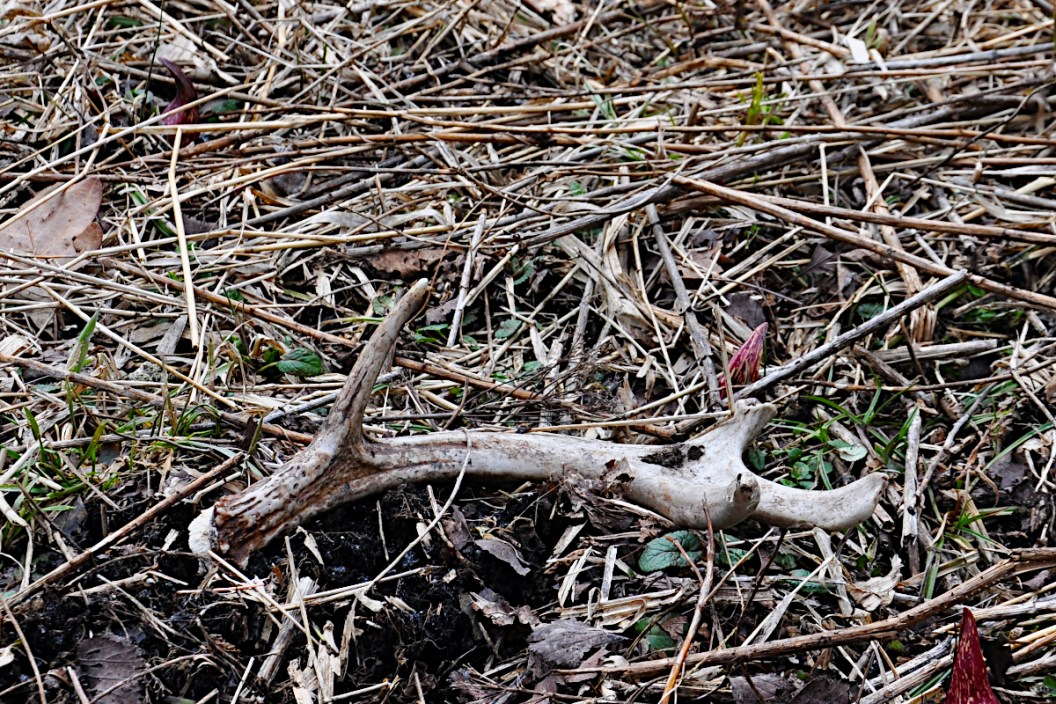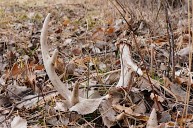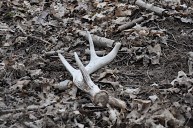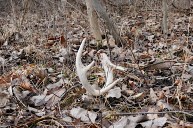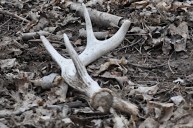It took me nearly ten years to find my first shed antler. Spring after spring was an exercise in frustration for me. I'd walk for hours and never came home with anything. I kept asking myself year after year why I even bothered to try shed hunting every year. Unfortunately, my experience is not uncommon. But it did make it that much more rewarding when I finally picked up a nice 4-point side while practically crawling my way through some heavy cover. I had a few more frustrating years after that where I might find only one or two small sheds before the flood gates finally opened for me around 2012. I found 11 that year, which I know isn't much for some states, but for Michigan, that's more than some shed hunters find in a lifetime.
Since then, my shed finding has been rather consistent. I find antlers every single year, and I even regularly match up sets. I like to say that I learned things the hard way, so you don't have to do the same. That's why today I'm presenting my top seven shed hunting tips. If you follow these tips, you'll drastically up your odds of picking up your first antler this year.
Cloudy Days Are Best
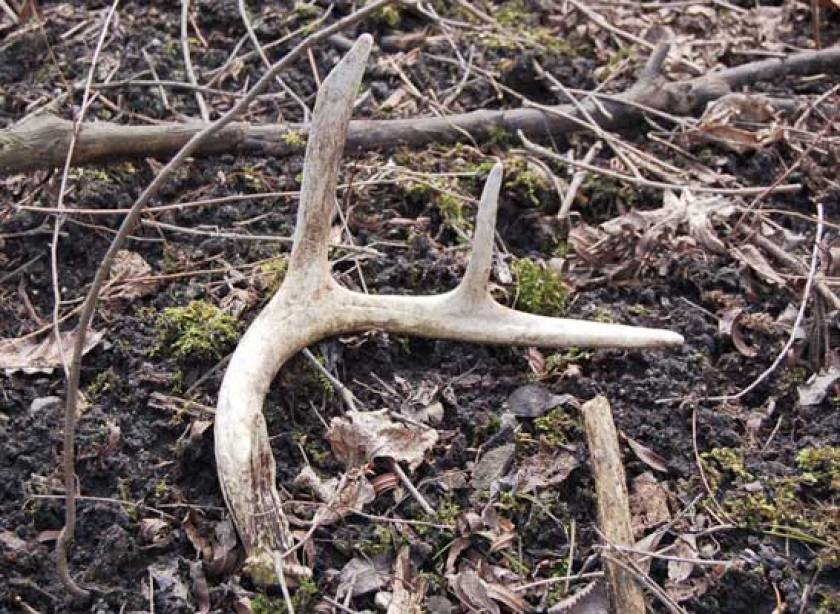
Travis Smola
In my opinion, this is the biggest mistake people make in looking for sheds. It's really tempting to run out and look for antlers on a bright, sunny spring day. Unfortunately, I've found that's the absolute worst time you can go look. Think of trying to spot a fish in a lake on a sunny day. It can be frustratingly difficult because of the glare. It's the same thing, albeit to a lesser degree, when trying to spot an antler similar in color and appearance to sticks and leaves of the forest floor. It's not that you can't find antlers on sunny days. I've found a few sheds off big bucks on sunny days. However, I usually find nothing, which is why I try to avoid them now. Cloudy days provide better contrast to discern antlers from the other junk in your hunting area.
I actually prefer rainy days over anything else. You not only avoid reflection from sunlight, but the rain helps mat down leaves and vegetation, making antlers stand out. Another benefit is wet antlers, no matter if they are from a whitetail deer, bull elk, or mule deer, they all give off a obvious sheen that most things in the woods do not. Once you learn to recognize this sheen, you'll be able to pick out antlers a lot more often.
Condition Your Eyes

Travis Smola
Granted, there are some people out there who are naturals at finding shed antlers. But, if you're like me, you might find that you have to train your eyes for it first. There are two, outside-the-box ways to do this. The simplest is taking an antler out in the woods, throwing it over your shoulder and then looking for it. It sounds stupid, but it works. You will find more deer antlers using this method.
The other method can be done anywhere on your laptop, tablet, or smartphone. Find a Facebook group, Reddit subgroup, or message board for shed hunting and become a regular there. Standard practice for these die-hard shed finders is to share photos of their finds exactly as they found them in the field. Most of the photos you see in this article are sheds exactly as I found them before picking them up.
It sounds odd, but I truly believe viewing these photos has helped condition my eyes to spotting antlers in a whole variety of weather conditions, terrain and situations. Think of it this way, remember how you had to train your eyes to spot wild game when you first started hunting? It's likely much easier for you now than when you started. Well, you need to do the exact same thing with shed antlers if you want to have regular success.
Never Stop Looking
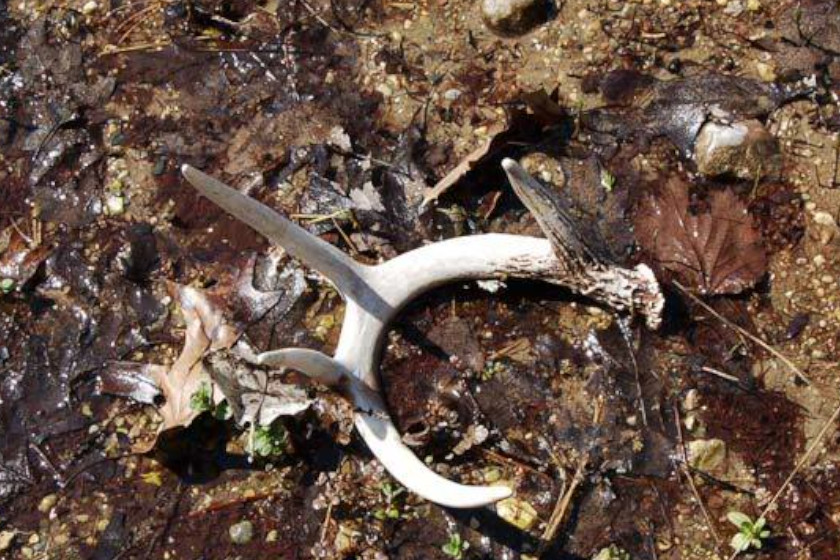
Travis Smola
The common myth is all the shed antlers are eaten up by squirrels, mice, and other creatures in the spring and you have to beat them to the prize. However, I've personally observed that isn't always true. Sometimes you can find antlers that are many years old. There are always going to be antlers on the ground to find. That's why I never really stop looking completely. I've found sheds while conducting summer trail camera checks, and even once while helping with a controlled brush burn. The flames swept over that antler giving it a cool dark brown coloration that makes for a great conversation starter.
Pay really close attention any time you're near a water source. I once found a matched set from a 110-inch, 7-pointer while kayaking in July. I spotted the 4-point side on the bank as I was paddling. As I was landing on shore to pick it up, I spotted the 3-point match laying half in the water less than ten feet away. In the case of that set, they were a bit discolored from proximity to the water, but did not have a single chew mark on them. Another time I was on vacation in Michigan's Upper Peninsula in August and I found a chewed-up three point side laying in some pine trees only 20 yards from the shore of Lake Michigan.
Obviously, when the spring green-up occurs, it becomes much harder to search. However, you can and should at least keep your eyes open for sheds all year round. Keep your eyes peeled while turkey hunting. Scan the sides of the trails during a summer hike, or while doing early-season scouting in the fall. Or while getting ready to work your food plot. Always looking for antlers does two things: it helps keep your eyes conditioned year-to-year, and you'll get an occasional find in the off-season in some unexpected places.
The shed in the photo above I found while keeping an eye on areas of deer sign while exploring a state fish hatchery. That was a May find. Another odd place I found one was while walking a two-track in a narrow strip of woods between a four-lane highway and the border fence of a National Guard training ground. It was September 19. One just never knows when or where they are going to find an antler! Especially in public areas. More people miss antlers than you might realize.
Think and Look Small
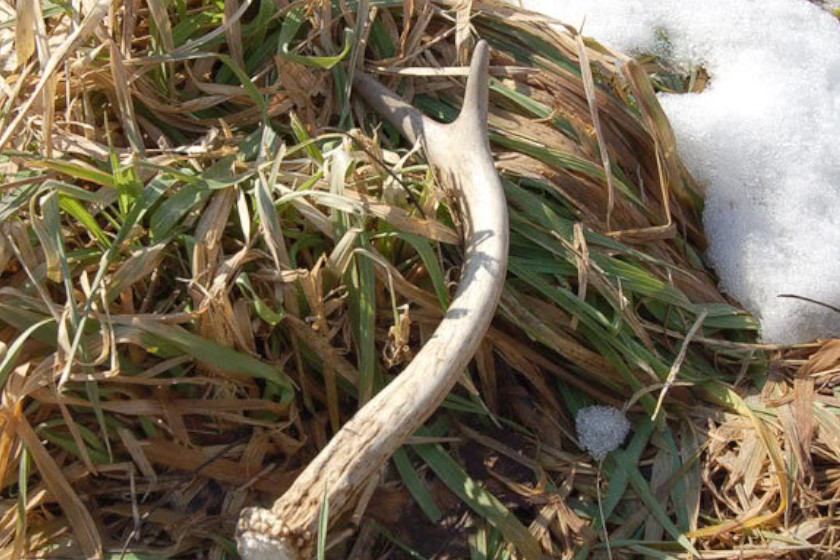
Travis Smola
Sure, everyone wants to find a massive four or five point side from a mature buck out in an open food plot or in a buck's bed, but it doesn't always work that way. In fact, it took me 25 years to find my first 5-point side! I think the mindset of finding a big antler hurts more than it helps. Don't look for a whole antler. I look for just a hint of an antler, a tine, main beam or just the base. I probably find more antlers by spotting the slight curve of the main beam than by any other method. Few fallen branches are going to have this same smooth curve.
If you're spotting broken pieces of antler or small animal bones that litter most any forest, you're doing things right. Keep at it, and the antlers will follow. Sometimes, I've found it to be more effective to simply look for bones, any kind of bones. Take every shed, no matter how small it is, as a victory and your confidence on your hunting trips will grow from there and eventually larger finds will come.
Slow Down!
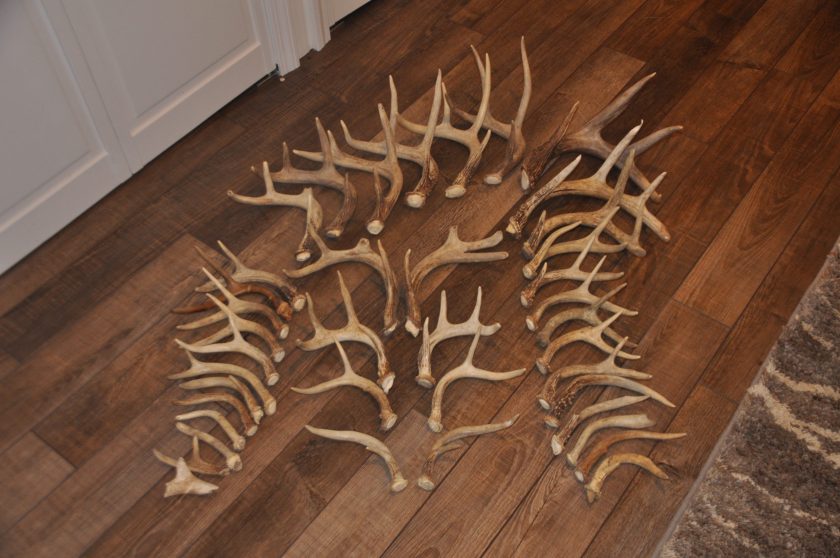
Travis Smola
I've read many articles that encourage people to ride ATVs in order to cover more ground much more quickly. In my experience, moving this fast just helps you miss antlers unless you have already trained your eyes to spot them. For perspective, I only have one find on my resume that I spotted from my vehicle. That was a nice 4-point side that had somehow gone a full year laying only five yards from a road. It was bleached white when I spotted it. Finds from a vehicle can happen, but moving quickly usually is going to hurt more than it helps. Sure, you might find some of the obvious ones out in the open, but you'll drive right past the ones that are better hidden.
If you think you're walking too slow, but still aren't finding any antlers, you probably still aren't walking slowly enough. Focus on one small area and very methodically walk a grid pattern. Focus on the ground in a 10-15 foot radius and not far ahead. This takes some patience, especially in an open field, but it works. Stop every once in a while to really survey the ground around you and behind you. Especially on public land where the antlers you'll be finding are likely to be smaller. I've walked within five feet of antlers in the open before and then not found them until my next pass. Don't worry about how much ground you can cover, but how thoroughly you can do it. I've spent an entire afternoon on one field or a south-facing slope before.
Have a Plan
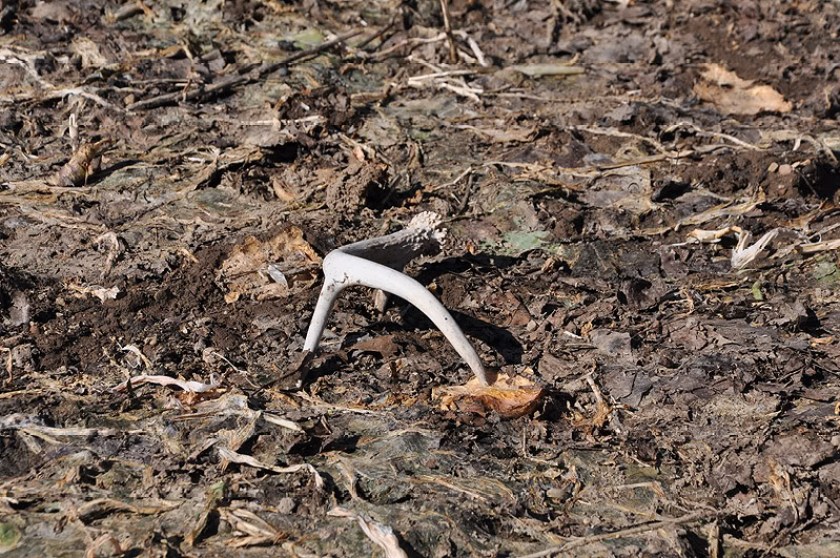
Travis Smola
While it's okay to go out and casually walk the woods randomly once in a while, do it too often though and you'll never find anything. Go into the woods prepared with a plan and stick to it. Don't get side-tracked. Use late-season scouting or trail camera photos to note where the deer are wintering and then work those areas methodically.
You should always work bedding areas and feeding areas more closely because those are where bucks are going to spend the majority of their time in winter. Even a plan to just spend an hour grid-searching a small bedding area or a food source is going to have a higher chance of success than simply following random deer trails through the woods. In fact, I spend very little time every year searching travel routes. I usually only start searching those once I've eliminated the possibilities of antlers being in the food plots or bedding areas.
Find Your zone
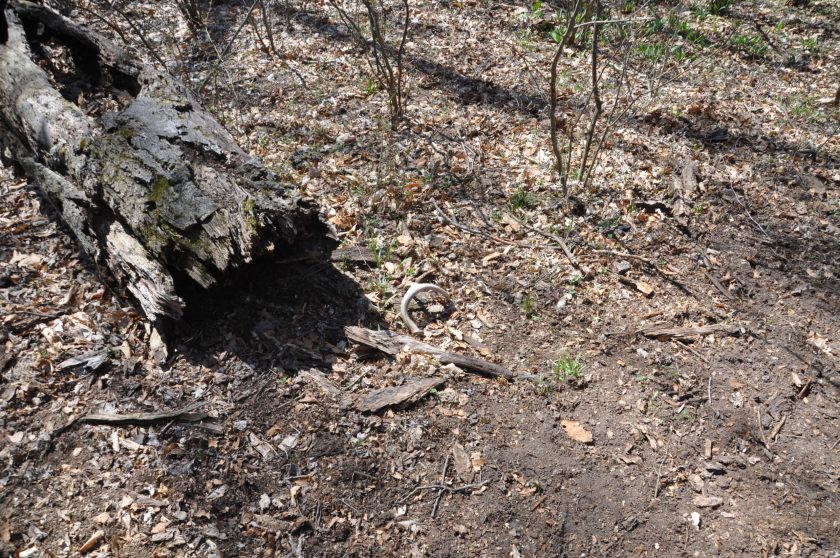
Travis Smola
Another thing I've learned is that finding antlers is as much mental as it is anything else. I hate Adam Sandler movies, but there's a good analogy to be found in the movie Happy Gilmore. In the movie, Happy stinks at putting the ball in golf until he mentally finds his "Happy Place." It's the same concept with shed hunting. If you're out there stressing about not finding anything, guess what will probably happen?
Shed hunting is supposed to be a relaxing and stress-free activity. If you're out looking physically, but mentally you're stressing over bills or yard work that you're putting off, you likely won't see a lot of success. In fact that goes for deer hunting the animals themselves too. That's why it's important to find enjoyment in just being outdoors and in the hike. Forget about your problems for a while. You'll know once you've found your personal shed hunting zone because the finds will come a lot easier. Then you just have to stick to it!
It's not easy to find cast deer antlers, but utilize some of what I've written here along with a little patience, and you can definitely up your odds, especially if you live in a high-pressure hunting state like Michigan where I live. The last, most important piece of advice I can give is don't give up! It took me years to find my first shed. Stick to it, and eventually you will have success!
For more outdoor content from Travis Smola, be sure to follow him on Twitter and Instagram For original videos, check out his Geocaching and Outdoors with Travis YouTube channels.
READ MORE: THE PERFECT TIME TO START THINKING ABOUT SHED HUNTING
